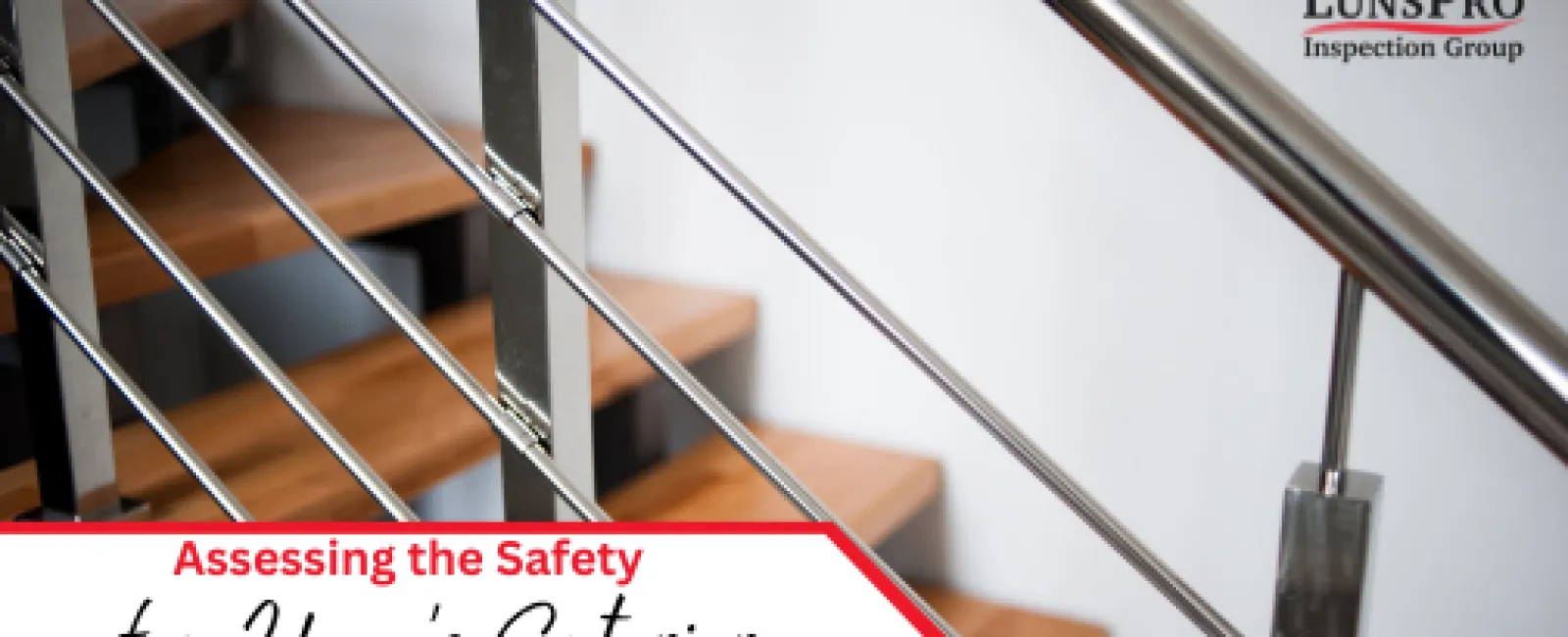When it comes to home safety, exterior stairs and handrails are often overlooked despite their critical role in preventing accidents. These features ensure accessibility, especially in homes with elevated entryways, decks, or porches. Over time, exposure to weather, wear and tear, and lack of maintenance can compromise their structural integrity.
For homeowners in North Carolina, ensuring that exterior stairs and handrails meet safety standards is particularly important. Not only does this help protect residents and visitors, but it can also impact property value and pass requirements during North Carolina home inspections. Trusted professionals like LunsPro Inspection Group are often called upon to evaluate the safety of these features during Carolina residential and commercial home inspections.
In this article, we'll explore how to assess the safety of your home's exterior stairs and handrails, common issues to look for, and the steps you can take to ensure they remain in excellent condition.
Why Exterior Stairs and Handrails Matter
Exterior stairs and handrails are not just functional—they are essential for ensuring the safety and accessibility of a home. They serve as a critical support system for people of all ages and physical abilities, especially during adverse weather conditions like rain, snow, or ice.
Failing to maintain these structures can result in serious consequences:
- Injuries: Slips, trips, and falls are among the leading causes of injuries at home.
- Code Violations: Improperly designed or maintained stairs and handrails may not comply with building codes, potentially complicating real estate transactions.
- Inspection Concerns: Issues with exterior stairs and handrails can raise red flags during North Carolina home inspections conducted by experts like LunsPro Inspection Group.
Key Components of Exterior Stairs and Handrails
To properly assess the safety of a home's exterior stairs and handrails, it's important to understand their main components:
1. Stairs
- Treads: The horizontal part of the stair where people step.
- Risers: The vertical portion between each tread.
- Stringers: The structural supports on either side of the stairs.
2. Handrails
- Graspable Rail: The part of the handrail that people grip for support.
- Posts: Vertical supports that anchor the handrail to the stairs or ground.
3. Landings
The flat area at the top or bottom of a staircase, providing a safe transition between levels.
Each of these elements must be evaluated for structural integrity, durability, and compliance with local building codes.
Steps to Assess the Safety of Exterior Stairs and Handrails
1. Inspect for Physical Damage
Begin by visually examining the stairs and handrails for visible signs of wear and tear. Look for:
- Cracks or splits in wooden stairs or handrails.
- Rust or corrosion on metal components.
- Warping or sagging of steps, which may indicate compromised structural integrity.
2. Check for Stability
Apply pressure to the stairs and handrails to ensure they feel secure. Wobbly stairs or loose handrails are a clear safety hazard and should be addressed immediately.
3. Measure the Dimensions
Ensure that the stairs and handrails meet safety standards:
- Tread depth and riser height: Uniform dimensions reduce the risk of trips.
- Handrail height: Typically, handrails should be 34-38 inches above the stair treads.
Proper measurements not only ensure safety but also ensure compliance with building codes often checked during Carolina residential and commercial home inspections.
4. Evaluate the Materials
Different materials require different maintenance approaches:
- Wood: Check for rot, splinters, or insect damage.
- Metal: Look for rust, especially at joints and connections.
- Concrete: Inspect for cracks or crumbling edges.
5. Assess Traction and Surface Conditions
Slippery stairs are a leading cause of falls. Ensure:
- Treads are equipped with non-slip surfaces or anti-skid strips.
- Debris or moss is cleared from stairs and landings regularly.
6. Review Handrail Accessibility
Handrails should be:
- Graspable: Rounded or shaped for a comfortable grip.
- Continuous: Running the full length of the staircase without breaks.
- Anchored securely to posts or walls.
Common Issues Identified During Inspections
Professionals like LunsPro Inspection Group often uncover recurring problems during North Carolina home inspections. Common issues include:
- Improperly spaced risers or treads: Variations in step height or depth can cause trips.
- Lack of handrails: Many older homes don't have handrails on both sides of the staircase.
- Loose connections: Nails, screws, or bolts may loosen over time.
- Rot or decay: Particularly in wooden structures exposed to moisture.
- Code violations: Many homeowners are unaware that their stairs or handrails don't meet modern safety standards.
How to Address Safety Concerns
1. Routine Maintenance
Regular cleaning, tightening screws or bolts, and applying protective finishes can prevent many issues.
2. Professional Repairs
For more significant problems like structural instability or extensive damage, hire a licensed contractor. They can rebuild or reinforce stairs and handrails to meet safety standards.
3. Upgrade to Code Compliance
If your home's exterior stairs and handrails don't meet current building codes, consider upgrading them. This not only enhances safety but can also increase your home's marketability during Carolina residential and commercial home inspections.
The Role of Professional Inspections
When in doubt, it's always best to consult experts. LunsPro Inspection Group specializes in comprehensive evaluations of home exteriors, including stairs and handrails. Their experienced inspectors assess safety, code compliance, and structural integrity during North Carolina home inspections.
Some benefits of professional inspections include:
- Early detection of issues: Identifying problems before they escalate.
- Expert recommendations: Guidance on necessary repairs or upgrades.
- Peace of mind: Assurance that your home meets safety standards.
Tips for Preventative Care
- Regular Cleaning: Remove dirt, leaves, and moss to prevent slippery surfaces.
- Sealing and Painting: Protect wooden stairs and handrails from moisture.
- Timely Repairs: Address small issues, such as loose screws or minor cracks, before they worsen.
- Seasonal Inspections: Check stairs and handrails before winter to ensure they can handle ice and snow.
Prioritizing Safety for Exterior Stairs and Handrails
Exterior stairs and handrails are vital components of any home, yet they are often neglected until a problem arises. By conducting regular assessments and staying proactive with maintenance, homeowners can ensure these features remain safe and functional.
For those preparing to sell their home or simply wanting peace of mind, professional inspections are invaluable. LunsPro Inspection Group, a trusted name in Carolina residential and commercial home inspections, provides expert evaluations to help identify potential hazards and ensure compliance with safety standards. Their thorough North Carolina home inspections are an essential resource for homeowners across the region.
Investing time and effort into maintaining exterior stairs and handrails not only enhances safety but also contributes to a home's overall value and appeal. Whether you're a homeowner, a property manager, or a prospective buyer, ensuring the safety of these critical features should always be a priority. With regular care and professional guidance, you can enjoy peace of mind and a safer living environment for years to come.

